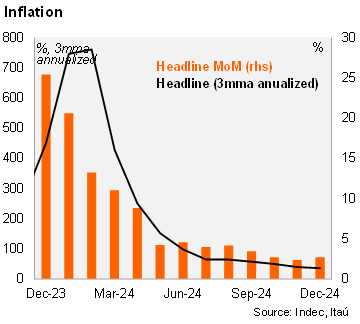According to Argentina’s statistical office (INDEC), consumer prices rose by 2.7% MoM in December, down from 2.4% MoM in November. The print was in line with market expectations, according to the latest central bank’s survey. Annualized quarterly inflation in December fell to 35.9%, down from 39.9% in the previous month. On an annual basis, inflation declined to 117.8%, from 211.4% in 2023.

The monthly core measure increased by 3.2% mom in December, marking an acceleration from the previous month (2.7% MoM) due to higher meat prices. Moreover, the year-over-year reading fell to 105.5%, from 155.4% in November. Prices for regulated products increased by 3.4% MoM and 205.9% YoY, led by higher energy tariffs and fuels. Finally, prices for seasonal products fell by 1.4% MoM due to lower fruits and vegetables prices (mainly tomatoes at -37.5% MoM). The year-over-year reading fell to 87.3% in December, from 120.8% in the previous month.

Separately, the central bank announced that it will reduce the crawling peg pace to 1.0% mom starting on February 1, down from 2.0% mom over the last twelve months. According to the short statement, the crawling peg policy plays an important role in anchoring inflation expectations. Thus, the government intends to double down on this strategy in 2025, at the cost of further appreciation of the currency and loss of competitiveness.
Our take: We expect the disinflation process to continue in 2025. We now see inflation at 25% in YE25, down from 30% in our previous scenario and well below the 117.8% yoy inflation in YE24. Our baseline scenario assumes that the central bank will also cut the policy rate (by 300 bps to 29%) after announcing the reduction of the crawling peg. The INDEC will release the January CPI on February 13.
